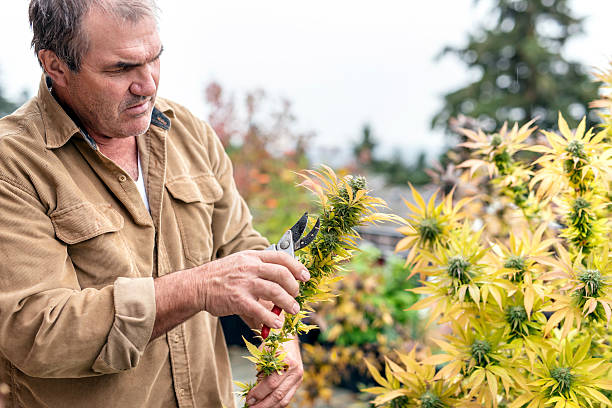If you’re growing your own plants or purchasing from trusted sources like Weed Delivery Halifax, understanding the ideal time to harvest cannabis is critical. Harvest too early and you risk weak potency and poor flavor. Wait too long and the cannabinoids degrade. Perfect timing ensures maximum strength, aroma, and medicinal value. This article dives deep into the science and visual cues to determine exactly when your cannabis is ready to harvest.
Why Timing Matters in Cannabis Harvesting
Harvesting cannabis is not just about cutting the plant when it looks big and bushy. Cannabinoid content, terpene profile, and overall effects vary depending on the precise time of harvest. Timing affects:
- THC and CBD Potency: Peaks at different times.
- Terpene Profile: Changes with exposure to oxygen and light.
- Yield and Density: Too early, and buds won’t fully mature.
Cannabis plants go through specific growth stages. The final stage, the flowering phase, is where the harvest timing magic happens.
The Cannabis Flowering Cycle
Understanding the lifecycle of cannabis helps in spotting the harvest window. Here’s a general timeline for photoperiod cannabis plants:
| Stage | Duration | Key Features |
|---|---|---|
| Vegetative | 3–8 weeks | Rapid leaf/stem growth |
| Early Flowering | Weeks 1–2 | Buds begin to form |
| Mid Flowering | Weeks 3–6 | Buds swell, trichomes develop |
| Late Flowering | Weeks 7–10+ | Trichomes mature, pistils change |
| Harvest Window | Weeks 8–11 | Visual and chemical indicators align |
Visual Signs That Cannabis Is Ready to Harvest
1. Trichome Color
Trichomes are tiny, crystal-like structures that hold cannabinoids and terpenes. Under a microscope or jeweler’s loupe (at least 60x magnification), you’ll notice:
| Trichome Appearance | Meaning | Recommended Action |
|---|---|---|
| Clear | Immature | Too early to harvest |
| Cloudy/Milky | Peak THC potency | Ideal for uplifting effects |
| Amber | THC degrading into CBN | Sedative, body-heavy high |
A perfect harvest often involves a mix: about 70% cloudy and 20–30% amber for a balanced effect.
2. Pistil Color
Pistils are the tiny hairs on the buds. Their color transformation is another signal.
| Pistil Color | Readiness Indicator |
|---|---|
| White | Still developing; not ready |
| Orange/Brown | 70–90% darkened = harvest window |
Rely more on trichome observation than pistils alone, but both together tell a more accurate story.
3. Leaf Condition
As the plant reaches full maturity:
- Fan leaves begin to yellow and curl.
- Nitrogen is naturally pulled from leaves to support bud production.
This is a natural part of the cycle, not a nutrient deficiency.
Effects of Harvest Timing on Cannabinoids
Here’s a comparison of cannabinoid effects depending on harvest timing:
| Harvest Time | THC Levels | CBD/CBN Levels | Common Effects |
|---|---|---|---|
| Too Early | Low | Low | Mild, less psychoactive |
| Peak Time | High | Moderate | Potent, euphoric, well-balanced |
| Too Late | Lower THC | Higher CBN | Sedative, sleepy, couch-lock |
Sativa vs. Indica Harvesting Times
Different strains mature at different rates. Knowing your plant genetics helps predict harvest time.
| Strain Type | Typical Flowering Duration | Harvest Notes |
|---|---|---|
| Sativa | 10–12 weeks | Slower to mature; wait for trichomes |
| Indica | 8–10 weeks | Faster flowering; pistils darken early |
Sativa strains tend to keep producing new white pistils longer, while indica plants mature more uniformly.
Environmental Factors That Influence Readiness
Even with perfect timing knowledge, environmental stress can impact your plant’s maturity:
- Light Cycle Changes: Can trigger premature flowering.
- Nutrient Stress: May speed up or delay trichome development.
- Humidity and Temperature: Affect trichome production and terpene retention.
Ideal conditions during flowering are 40–50% humidity and 20–26°C for most strains.
Pre-Harvest Flushing
Flushing means feeding your plants only water for 7–14 days before harvest. It helps remove excess nutrients from the soil, improving flavor and burn quality.
| Benefit of Flushing | Result |
|---|---|
| Removes salt build-up | Cleaner taste |
| Reduces harshness | Smooth smoke |
| Enhances terpene expression | Better aroma |
Common Mistakes to Avoid
- Harvesting Based on Calendar Alone: Always observe trichomes and pistils.
- Ignoring Plant Stress Signs: Nutrient burn or deficiency can mislead visual cues.
- Not Using Magnification Tools: Trichomes are too small to evaluate with the naked eye.
Final Harvest Checklist
Before cutting your plants, go through this quick list:
| Checklist Item | Status |
|---|---|
| 70%+ pistils have turned dark | ✔️ |
| Trichomes mostly cloudy, some amber | ✔️ |
| Fan leaves yellow and curling | ✔️ |
| Flushed for 1–2 weeks | ✔️ |
| No major pest or mold issue | ✔️ |
If you can tick off most of these, your plant is likely ready for harvest.
After the Harvest: What’s Next?
Once harvested, cannabis must be properly dried and cured to retain potency, flavor, and shelf life. Poor drying can ruin weeks or months of hard work. After cutting, hang your branches in a dark, ventilated room with 50% humidity for 7–10 days before trimming and curing in jars.
If you’re unsure about when to harvest or how to dry, local delivery services like halifax cannabis delivery, halifax weed delivery, or Weed delivery Darmtouth may offer expert-grown buds harvested at the right time.
Conclusion
Knowing when cannabis is ready to harvest is a skill that improves with experience. By closely monitoring trichomes, pistils, and overall plant health, growers can harvest at the optimal time for maximum potency and effect. Whether you’re a home grower or rely on trusted sources like Weed Delivery Halifax, the key is patience and observation. Mastering the harvest window ensures your cannabis is potent, flavorful, and effective—every single time. For more visit techchrons.


